Lenovo Yoga Book 9i review: The right kind of weird
Expert’s Rating
Pros
- Versatile dual-screen design
- OLED displays have excellent image quality
- Loud, bass-heavy audio
- Great webcam and microphone
Cons
- Mediocre keyboard, frustrating touchpad
- Lackluster performance
- Not the best value for money
Our Verdict
Lenovo’s dual-screen Yoga Book 9i is an expensive, but successful proof of concept.
Price When Reviewed
$1,999.99
Best Prices Today: Lenovo Yoga Book 9i

$1999.99
Lenovo has a history of experimental dual-screen laptops. The ThinkPad X1 Fold offers a flexible, folding OLED display, the ThinkBook Plus Twist has an extra e-ink screen, and the ancient ThinkPad W700ds had a slide-out second display. The Yoga Book 9i builds on these ideas to deliver a versatile, functional 2-in-1 that packs maximum display real estate into a 13.3-inch chassis.
Looking for more options? If so, check out PCWorld’s roundup of the best 2-in-1 laptops available right now.
Lenovo Yoga Book 9i: Specs and features
The Yoga Book 9i’s key specification is the display or, rather, displays. It has a pair of 13.3-inch OLED touchscreens, one for each half of the laptop. The upper display functions as would normally be expected, but the lower display can be used either as a secondary monitor or an input device.
- CPU: Intel Core i7-1355U
- Memory: 16GB LPDDR5
- Graphics/GPU: Intel Iris Xe
- Display: 2x 13.3-inch 2,880 x 1,800 OLED touchscreen
- Storage: 1TB PCIe Gen4 SSD
- Webcam: 1440p
- Connectivity: 3x Thunderbolt 4/USB-C
- Networking: WiFi 6E, Bluetooth 5.1
- Biometrics: IR Camera for Windows Hello facial recognition
- Battery capacity: 80 watt-hours
- Dimensions:11.84 x 8 x .63 inches
- Weight: 3.51 pounds
- MSRP: $1,999.99
The 2-in-1’s internal hardware is mundane, however, with an Intel Core i7 processor, Intel integrated graphics, and 16GB of RAM. Its modest performance can seem unappealing given Lenovo’s expensive $1,999.99 MSRP. Make no mistake: this 2-in-1 is all about the displays.
Lenovo Yoga Book 9i: Design and build quality

IDG / Matthew Smith
The Lenovo Yoga Book 9i’s exterior is similar to Lenovo’s Yoga 9i aside from the blue colorway, which is a refreshing change from the usual gray or silver. Lenovo delivers a premium look with expanses of brushed aluminum that soften into chrome curves along the perimeter of the chassis. The curves offer unique flair and make the 2-in-1 more comfortable to hold.
Once you open the Lenovo Yoga Book 9i, however, things get a bit weird. It has dual displays that cover both the top and bottom halves of the 2-in-1. Both support touch, and both are glossy, so the 2-in-1 is a serious fingerprint magnet. However, this design offers some perks when using the device as a 2-in-1.
There’s a ton of flexibility in how the device is held and used. The Yoga Book 9i’s bottom half can fold 360 degrees for use as a standard tablet, or it can be held like a book with both displays in use at once. It can be used in tent mode, where the bottom half becomes a kickstand, or laid flat on a table to become a large touchscreen canvas. And, of course, it can be used as a clamshell laptop.
And then there’s Lenovo’s party trick: the Yoga Book 9i’s stand. Otherwise used as a cover for the detachable keyboard and the stylus, it can fold into a stand for the 2-in-1 itself. In this mode, the 2-in-1 can be held with both displays visible in either a vertical or horizontal position. The keyboard is then placed below the screens. When used in this mode, the tiny Yoga Book 9i can provide a larger display surface than an 16-inch clamshell laptop. It’s a genuinely useful option for travelers who often have many apps open at once. Just be warned: the kickstand is only stable on a flat surface like a desk or table.
The Yoga Book 9i’s design is unusual, to be sure, but it doesn’t feel like a gimmick. Packing two touchscreens into a 13-inch laptop makes for a compact yet functional 2-in-1 ideal for comparing documents, research, or editing spreadsheets. The large displays and included stylus should appeal to digital artists and makes for a superb digital notebook.
Lenovo Yoga Book 9i: Keyboard, trackpad
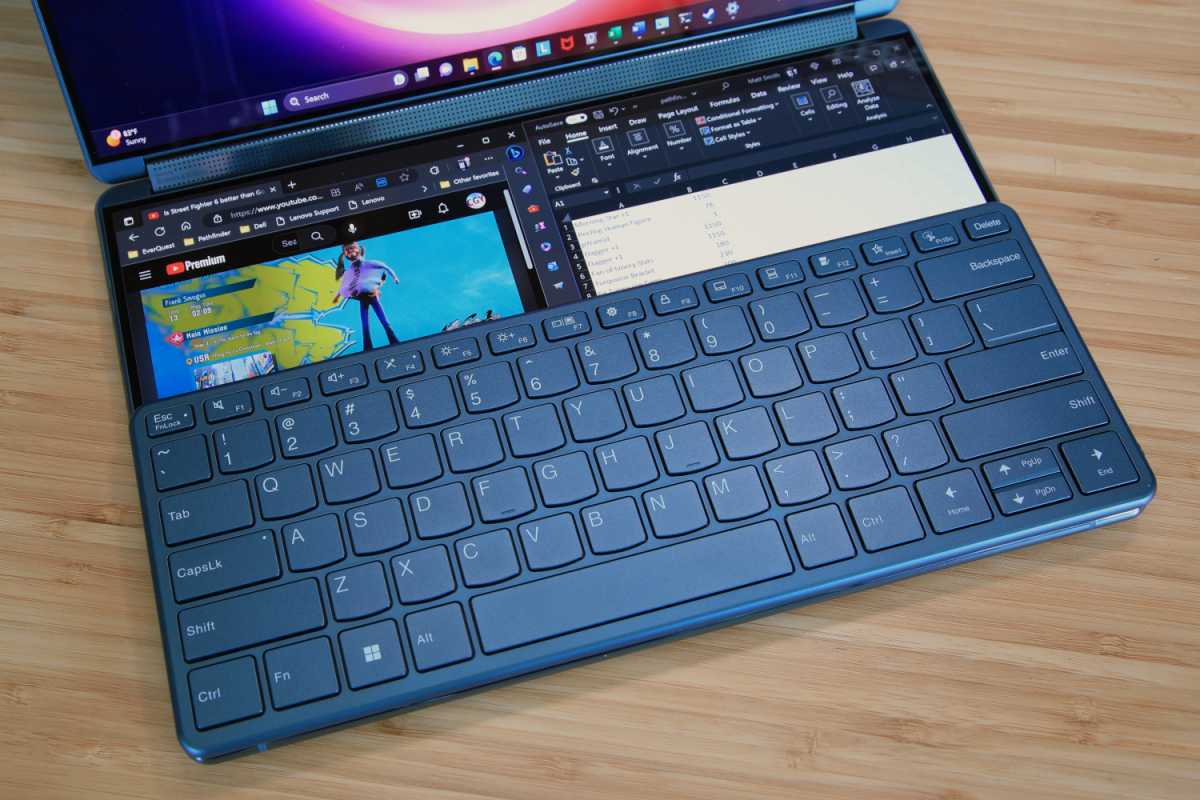
IDG / Matthew Smith
That is not to say, however, that the device’s design is perfect. The keyboard and touchpad pay a price for the 2-in-1’s attractive dual display design.
A bundled wireless keyboard connects to the Yoga Book 9i via Bluetooth. When used as a laptop, the keyboard is placed in a position just below the primary display, but it can also be used on a desk, attached magnetically to the kickstand, or shifted towards the bottom half of the laptop, which enables a portion of the lower display.
The flexibility is appreciated but, when used as a traditional clamshell laptop keyboard, the typing experience proves awkward. The keyboard is raised noticeably above the palm rest surface, leaving the user’s wrists to dangle.
While the keyboard can be uncomfortable, the touchpad is downright annoying. A virtual touchpad appears below the keyboard when it’s used as a laptop. It’s difficult to know if your fingertip is within the touchpad surface without glancing, as there’s now tactile feedback. I also noticed that, in some cases, the cursor ends up hidden beneath the keyboard on the lower display or otherwise seems unresponsive. I experienced frequent unintended mouse inputs, as well. The right-click function was touchy and frequently opened options menus I didn’t ask for.
These problems are understandable given the laptops design, but important to note. Buyers who plan to use a 2-in-1 primarily as a traditional clamshell laptop, and only occasionally as a dual-screen tablet or canvas, will find the keyboard and touchpad disappointing.
Lenovo Yoga Book 9i: Display, audio
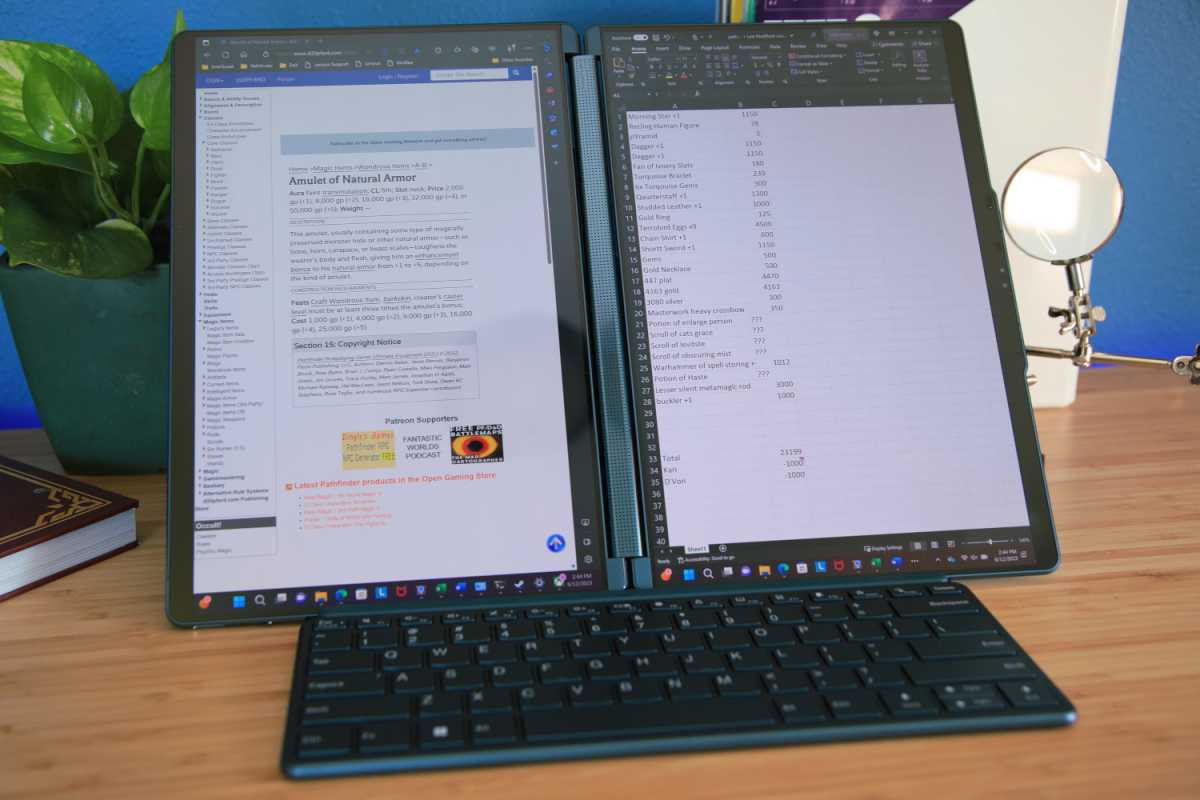
IDG / Matthew Smith
The Lenovo Yoga Book 9i’s dual displays are mirror images of one another. Both measure 13.3 inches diagonally, support touch input, have a resolution of 2880 x 1800, and use an OLED panel.
They also look excellent in all situations. OLED provides superior contrast with deep inky black levels and superior shadow detail. Color performance is great, too, with a wide color gamut and solid color accuracy. Color is presented with a vivid, hyper-saturated look that should please most people.
Sharpness is superb with a pixel density of roughly 255 pixels per inch. That’s more than an Apple MacBook Pro’s Retina display and close to a 4K display on a larger 16-inch laptop. The displays cram over 10.3 million pixels in total, which is two million more than the roughly 8.3 million pixels of a 4K display.
My measurements found the laptop can slightly exceed its promised 400 nits of brightness, which is more than enough for use in a home office. However, the glossy finish of each display allows ample glare whenever a bright light source is nearby. The displays are a top-tier fingerprint magnet, as well, which can make the 2-in-1 look grody after just a day of use. Be sure to pack a microfiber cloth.
Audio quality is an unexpected highlight. The Yoga Book 9i, like the Yoga 9i, has a powerful Bowers & Wilkins sound system built into the display hinge. It provides loud, clear audio with surprising bass and a broad soundstage. The result is a voluminous yet crisp audio presentation that’s uncommon among laptops, most of which sound crowded and tinny. The Yoga Book 9i is well suited for music, movies, and games, and easily fills a home office with sound.
Lenovo Yoga Book 9i: Webcam, microphone, biometrics
Lenovo offers another surprise win with the webcam. A bump-out in the top of the display bezel provides room for a five-megapixel webcam that can record video at up to 1440p resolution and 30 frames per second. Video is sharp even in a room with only modest lighting. The camera picks up accurate and well-saturated colors that will help you look your best.
Audio is recorded through a noise-canceling microphone array. Audio comes through crisp and clear, but remains tinny, so I wouldn’t recommend it for podcasts or YouTube. If you just need to jump on a video call, however, it’s more than adequate.
Biometric login is supported through the webcam via Windows Hello facial recognition and provides a quick, hands-free way to access the device. The 2-in-1 also offers “zero touch login” and “zero touch lock,” which use the camera to detect when you are present at the computer. When on, these features automatically wake the 2-in-1 when you sit down in front of it and automatically lock it when you step away. They’re genuinely useful, and rather accurate, but can be turned off if desired.
Lenovo Yoga Book 9i: Connectivity
Physical connectivity is limited, as the Yoga Book 9i has just three Thunderbolt 4/USB-C ports. All of them can be used to charge the laptop, but the lack of USB-A ports or dedicated video output means most owners will need an adapter.
The device’s unique design can also cause some frustration. For example, using the 2-in-1 in its vertical dual-display mode, with each display in portrait orientation, cuts off access to at least one of the Thunderbolt 4/USB-C ports.
It’s clear Lenovo intends owners to lean heavily on wireless peripherals. Fortunately, the 2-in-1 supports the latest Wi-Fi 6E standard as well as Bluetooth 5.1. Wi-Fi connectivity was reliable in my time with the device and I had no issues with Bluetooth connectivity.
Lenovo Yoga Book 9i: Performance
The Lenovo Yoga Book 9i is not a large 2-in-1, and that has consequences for its performance. It packs Intel’s Core i7-1355U processor which has a total of 10 cores and a maximum turbo boost of 5GHz. It looks good on paper, but only two of the cores are “performance” cores, while the rest are significantly less capable “efficient” cores. Lenovo also makes do with Intel integrated graphics. 16GB of LPDDR5x memory and a 1TB PCIe Gen4 solid-state drive round out the device’s specifications.
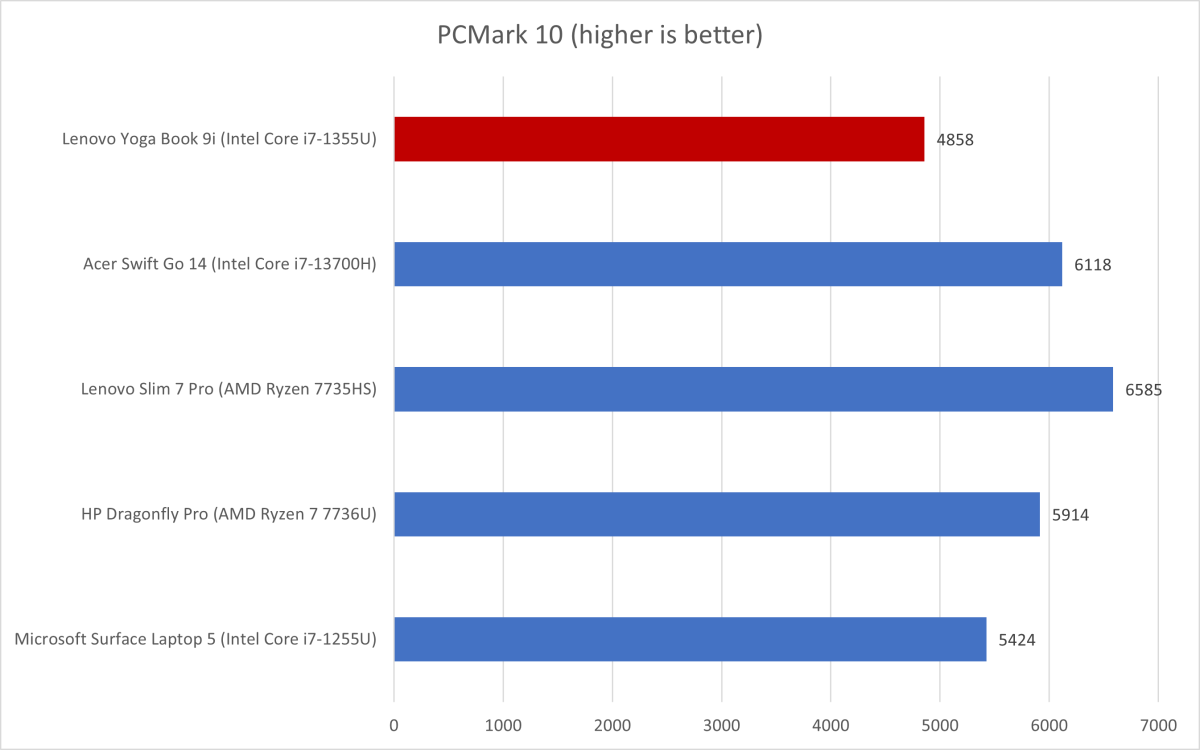
IDG / Matthew Smith
PCMark 10 paints a disappointing picture of the Yoga Book 9i’s performance with a combined score of 4,858. That is significantly lower than most recent laptops and even a hair behind the Microsoft Surface Laptop 5, which we last tested with an older Intel Core i7-1255U processor.
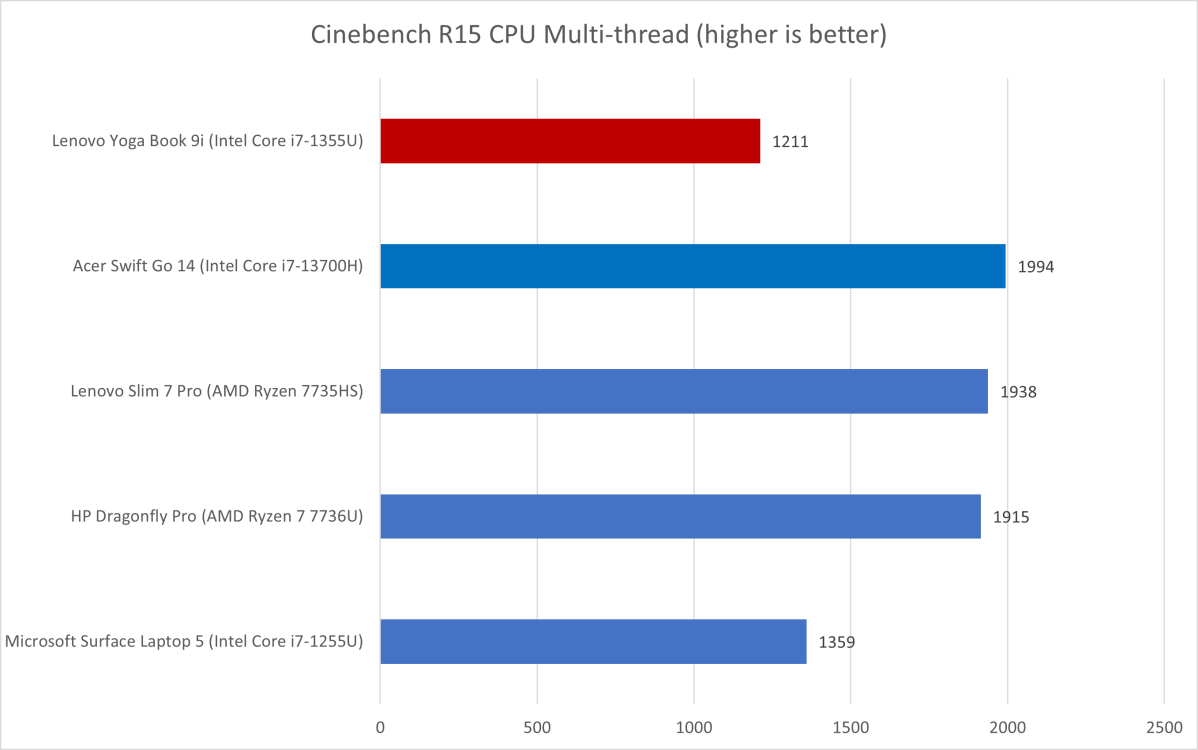
IDG / Matthew Smith
The Yoga Book 9i’s modest performance continues in Cinebench R15, where the 2-in-1 hits a multi-core score of just 1,211. This again falls behind the Microsoft Surface Laptop 5 and is significantly behind other 13 and 14-inch laptops such as the Lenovo Slim 7 Pro and HP Dragonfly Pro.
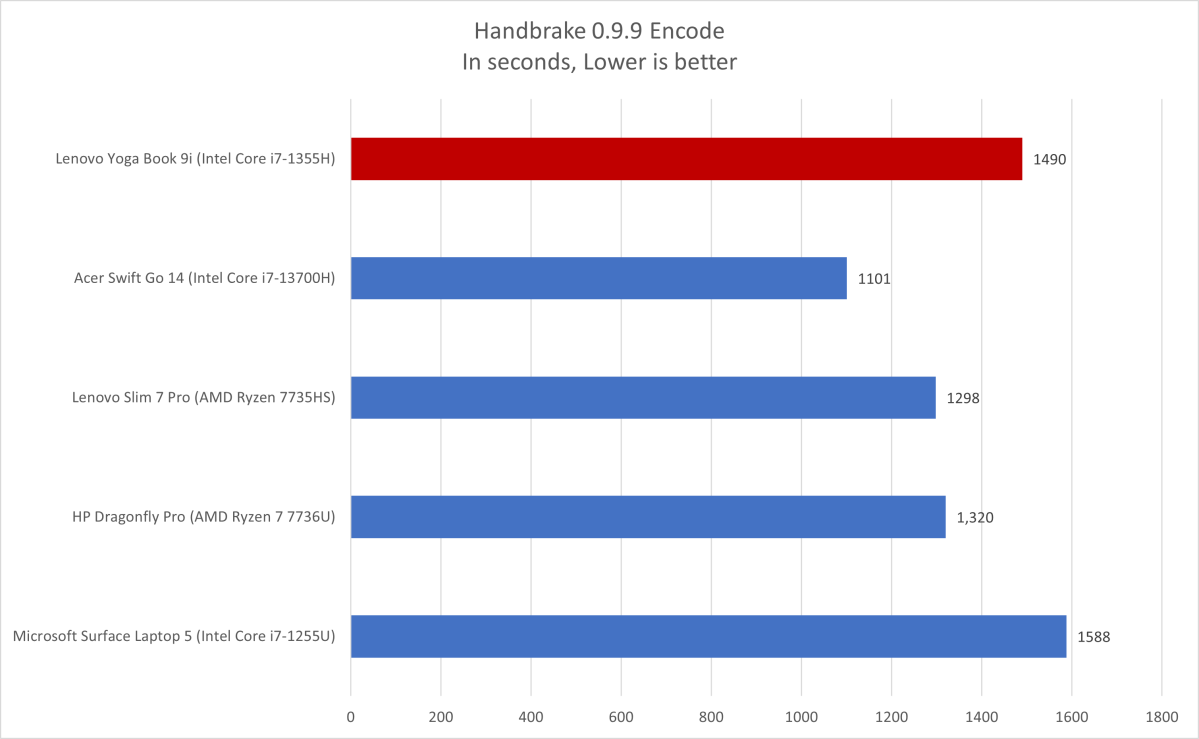
IDG / Matthew Smith
Handbrake provides the Yoga Book 9i an opportunity to score a small win over the Microsoft Surface Laptop 5, but it remains behind most laptops of similar size. Clearly, the Yoga Book 9i is tuned to focus more on portability than performance.
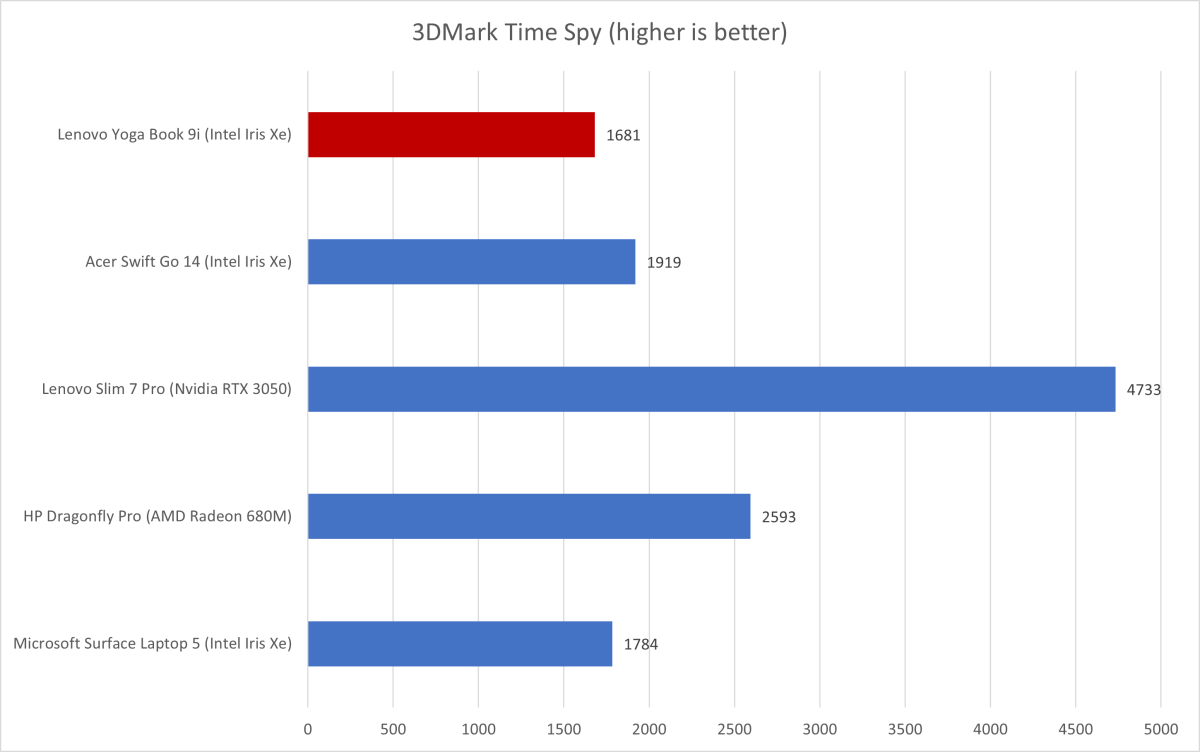
IDG / Matthew Smith
3DMark Time Spy, a graphics test, also delivers disappointing results. The Yoga Book 9i once again finds itself behind its competitors, including laptops that also use Intel Iris Xe graphics. The HP Dragonfly Pro, which provides integrated AMD graphics as part of its AMD Ryzen 7 7736U, is roughly 50 percent quicker.
The Yoga Book 9i’s performance is enhanced when the laptop is set to Extreme Performance mode. Its Cinebench R15 score rises from 1,211 to 1,439, while 3DMark Time Spy improves from 1,681 to 1,289. Overall performance remains mediocre, however, and comes at the expense of added fan noise and toasty external temperatures.
Lenovo’s Yoga Book 9i feels snappy in day-to-day use, but benchmarks make its limits clear. It’s not a device for high-resolution content creation, streaming, gaming, or other demanding tasks. This isn’t a surprise given its small size, but lackluster performance cuts against the 2-in-1’s value. Most price-competitive Windows machines offer quicker hardware.
Lenovo Yoga Book 9i: Battery life
The Yoga Book 9i’s dual screen design places a strain on the battery, which must power twice as many pixels as usual. Lenovo offsets this with a sizable 80 watt-hour battery that delivers acceptable, if not outstanding, endurance.
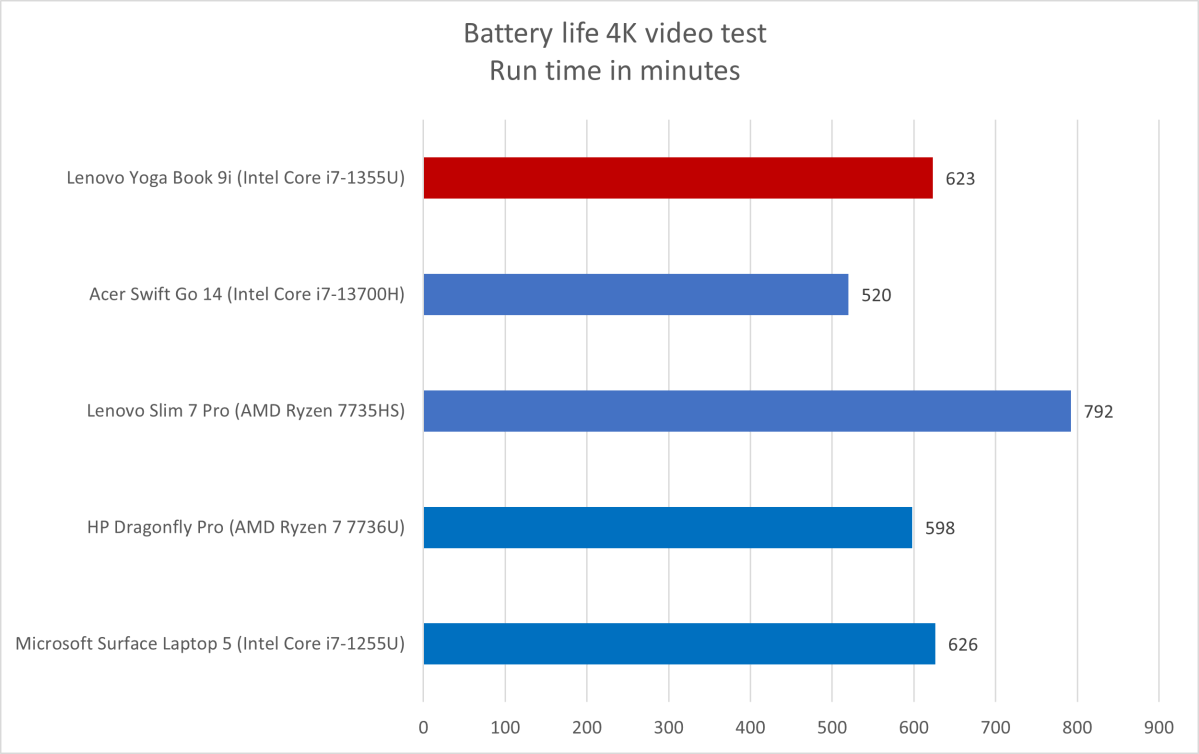
IDG / Matthew Smith
I recorded 10 hours and 23 minutes of runtime in our standard 4K video playback test. This is comparable to laptops and 2-in-1s of similar size and price: the Lenovo Slim 7 Pro lasted over an hour more, but the HP Dragonfly Pro lags by a half-hour.
Lenovo’s use of Thunderbolt 4 / USB-C to charge the laptop, along with its modest hardware, makes it easy to charge on the go. Third-party GaN chargers that deliver at least 65 watts will charge the laptop without issue.
Lenovo Yoga Book 9i: Should you buy it?
The Lenovo Yoga Book 9i is a successful experiment in dual-screen PC design that raises the bar for its competitors. Its slim profile, 360-degree hinge, and attractive OLED screens are well-suited for touch input or use with the included stylus. The wireless keyboard and virtual touchpad are frustrating, however, and can make the 2-in-1 frustrating when used as a laptop. The $2,000 price tag also guarantees the Yoga Book 9i’s appeal will remain limited. Still, if you’re a frequent flier who often uses a portable monitor, or a fan of using a stylus, Lenovo’s Yoga Book 9i could be the right kind of weird.
For all the latest Technology News Click Here
For the latest news and updates, follow us on Google News.
